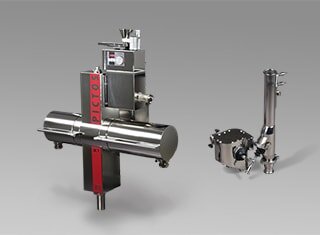Dynamic image analysis in process environment for dry powders, granules, suspensions and emulsion from 1 µm to 10,000 µm
The powerful and proven system components of QICPIC are also available for process integration. With PICTOS & Co disperser and sensor of QICPIC are integrated into one robust body, developed specifically for dry and wet on-line applications. Process-related particle size and particle shape characterization is realized with integrated image analysis sensors PICTOS, PICTIS & PICCELL covering a size range from 1 µm to 10,000 µm.
PICTOS integrates QICPIC dynamic image analysis and RODOS dry dispersion technology in a robust body, which was specifically developed for on-line applications. PICTIS combines image analysis and gentle gravitational disperser GRADIS, allowing at-line or on-line applications in process environments. And PICCELL with its flow-through cuvette finally transfers wet dispersion to on-line operations of image analysis. Feeding of PICTOS is realised either with dynamic and representative sampling system TWISTER, blending MIXER or static L-probes. Also, automatic or user-operated manual feeding is an option. PICTIS is fed manually or automatically by existing samplers and PICCELL is connected to the process line via a bypass.
An integration into control systems for processes or for automated laboratories is realised with common communication standards such as Modbus®, Profibus® or OPC (Open Platform Communications) with TCP/IP, RS232 or RS485. The system performs the measurement and reports back the measurement results to the control system. The process-specific dynamic image analysers PICTOS & Co. find a wide range of applications from foundry sand to pharmaceutical products, from roughest industrial conditions to GMP environments.
PICTOS & Co. Family
The PICTOS family includes different solutions according to their installation environment:
| Sensor | Versions | Measuring range/ Modules |
|---|---|---|
| on-line | PICTOS & TWISTER | 1.8 µm to 3,500 µm/ 4 |
| on-line | PICCELL | 1 µm to 5,000 µm/ 5 |
| at-line | PICTOS & VIBRI | 1.8 µm to > 3,500 µm*/ 4 |
| at-line | PICTIS & VIBRI | 1.8 µm to 10,000 µm**/ 4 |
| off-line | PICTOS & VIBRI | 1.8 to > 3,500 µm*/ 4 |
| off-line | PICTIS & VIBRI | 1.8 µm to 10,000 µm**/ 4 |
| * for fibres | ||
| ** upper value for compact shapes |
- Particle size, particle shape, fibre characterisation
- Efficient dry dispersion ensuring complete dispersion for fine, even cohesive powders, granules and fibres down to the submicron range with PICTOS
- Gentle dispersion for free-flowing, coarser or even metastable powders, fibres and granules millimetre range with PICTIS
- Highly sensitive analysis of suspensions and emulsions with PICCELL
- Measurement outside the process line under process-related conditions
- Valid method transfer due to comparability to the established off-line image analysers QICPIC with RODOS, GRADIS or LIXELL using the same core components
- Real-time analyses at the process
- GMP design for regulated environments
- Remote control of the measurement procedure via TCP/IP or serial interface
Download more information about PICTOS family
Forgot your password?
Please enter your username or email address. Instructions for resetting the password will be immediately emailed to you.
Are you interested in additional content? Please register an account. After confirming the registration link brochures, application notes and other documents on particle measurement will be available for download.
Together with the representative sampler TWISTER, the image analysis sensor PICTOS forms a perfectly coordinated and robust on-line process analysis system for fine, even cohesive powders, granules and fibres. PICCELL with its flow-through cuvette finally transfers wet dispersion of suspensions and emulsions to on-line operations of image analysis. PICTOS and PICCELL are operated in a bypass line to the main process stream and supplied with product samples from the product stream via a sampling system.
The PICTOS & VIBRI system can also be used as a manually operated laboratory instrument. The process-design of the sensor is ideal for analyses in batch production or in the pilot plant. As standard, the systems are pre-equipped for potential integration at a later date into an at-line laboratory automation system.


















